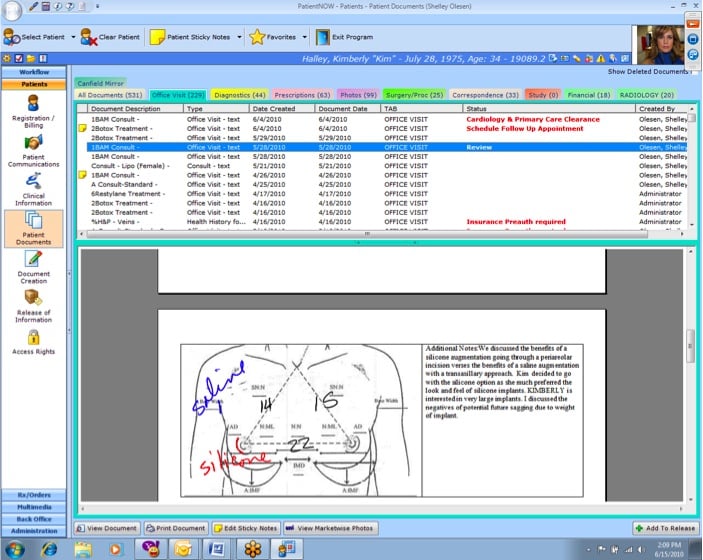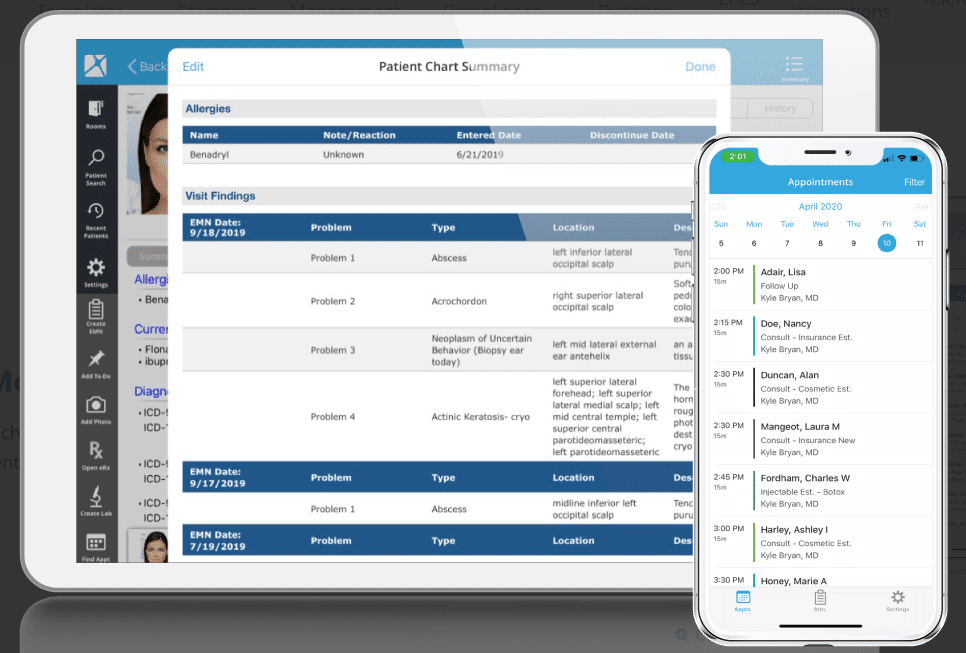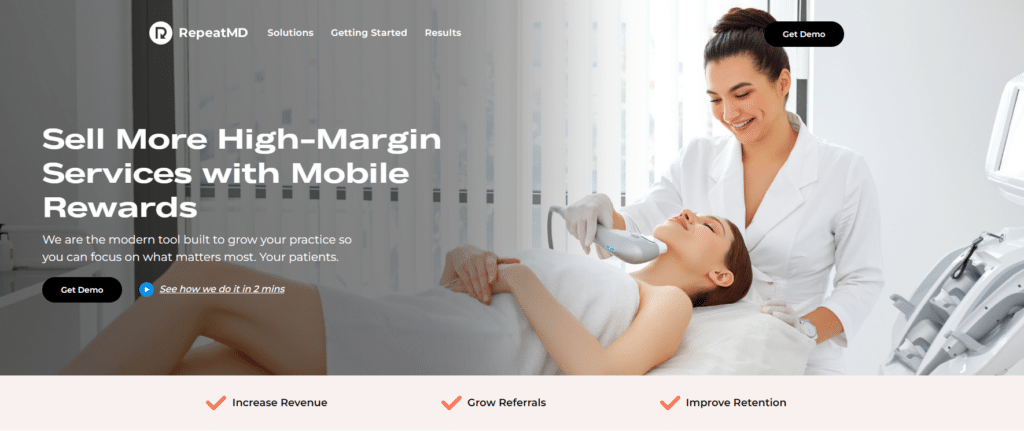12 Best Dermatology Software Shortlist
After a thorough review, I've curated the top 12 dermatology software:
- Kareo - Best for all-in-one practice management
- DermEngine - Best for intelligent dermatology imaging
- Compulink Dermatology Advantage - Best for customization and comprehensive EHR
- PatientNow - Best for patient engagement and retention
- ModMed - Best for adaptive learning and intuitive design
- PracticeStudio X20 - Best for integrated health records and practice management
- Nextech - Best for versatile functionality in a niche-specific package
- Dr Chrono - Best for cloud-based mobility and accessibility
- ClinicSense - Best for streamlined scheduling and invoicing
- Noterro - Best for simple user interface and practical features
- Accuro - Best for powerful patient-centric features
- RepeatMD - Best for automating patient follow-up and retargeting
The best dermatology EMR systems are those that seamlessly integrate practice management, offer real-time access on both iPhones and iPads, and handle key tasks such as patient scheduling, check-in, inventory management, and eligibility checking. Such tools should also cater to the specific needs of dermatology, recognizing the unique challenges presented by skin conditions and skin cancer.
The key advantage of adopting these systems is how they harmonize every aspect of your practice – from electronic medical records to revenue cycle management (RCM), helping you achieve maximum profitability. They'll offer features that align with ICD-10, ONC-ATCB Certified, and Meaningful Use standards, guaranteeing a smooth reimbursement process and ensuring you meet MIPS requirements.
When selecting, focus on software that caters to multi-specialty and specialty practices. A truly effective dermatology EMR tool should cater to these needs, particularly with a user-friendly interface accessible via smartphones, and web-based platforms for added convenience. It's this kind of solution that will free you from the hassle of managing numerous systems, allowing you to focus on what you do best – providing top-notch care for your patients.
What Is Dermatology Software?
Dermatology software is an innovative technological solution tailored to the unique requirements of dermatologists and their clinical practices. This specialized software is leveraged by dermatology professionals worldwide to manage a multitude of tasks, including electronic health records (EHR), appointment scheduling, billing, and even complex procedures such as diagnostic imaging.
The software is designed to streamline practice operations, enhance patient engagement, facilitate accurate diagnoses, integrated practice management, and ultimately improve the overall quality of patient care. It serves as a versatile tool that adapts to the needs of each practice, allowing dermatologists to focus more on patient care and less on administrative tasks.
12 Best Dermatology Software Overview
1. Kareo - Best for all-in-one practice management

Kareo stands as a comprehensive platform designed to assist healthcare providers in managing their practices. Providing an all-in-one solution, it integrates clinical, billing, and patient experience components in one place.
Why I Picked Kareo:
I selected Kareo for this list due to its impressive ability to consolidate multiple facets of practice management into a singular, user-friendly platform. Its all-in-one nature reduces the need for multiple standalone software solutions, thus enhancing operational efficiency. Furthermore, it stands as the "best for all-in-one practice management" due to its integration of clinical, financial, and patient experience management, covering all key aspects of a thriving practice.
Standout Features & Integrations:
Kareo boasts features such as advanced EHR capabilities, streamlined billing management, and an effective patient portal, all designed to support a comprehensive practice management solution. Its integrated approach results in a highly efficient workflow that boosts productivity. Moreover, Kareo integrates well with leading labs and pharmacies, ensuring your practice is well-connected.
Pricing:
From $150/user/month (billed annually)
Pros:
- Consolidated platform for managing all practice operations
- Robust EHR capabilities enhance record keeping
- Seamless integration with labs and pharmacies
Cons:
- Higher starting price compared to other platforms
- Billing is done annually rather than monthly
- The platform might require some training to use efficiently
2. DermEngine - Best for intelligent dermatology imaging

DermEngine is a sophisticated dermatology software that brings the power of intelligent imaging to your practice. The platform is equipped to handle intricate imaging tasks crucial to dermatological diagnostics, making it the best in its category for intelligent dermatology imaging.
Why I Picked DermEngine:
I singled out DermEngine for this list for its pioneering application of artificial intelligence in dermatological imaging. This software elevates the standard of diagnostic imaging, which forms a significant component of dermatology. It is "best for intelligent dermatology imaging" because its intelligent imaging capabilities make intricate dermatological diagnostics more precise and less labor-intensive.
Standout Features & Integrations:
DermEngine features intelligent dermatology imaging that incorporates artificial intelligence to support accurate diagnoses. It also provides digital dermoscopy and total body photography, which are key to thorough dermatological examinations. The software integrates smoothly with other EHRs and practice management systems, making it a flexible addition to any practice.
Pricing:
Pricing upon request
Pros:
- Offers artificial intelligence-based imaging for precise diagnoses
- Integrates with existing EHRs and practice management systems
- Provides digital dermoscopy and total body photography capabilities
Cons:
- Pricing information is not readily available
- May require a learning curve to fully utilize AI capabilities
- The extensive features might be overwhelming for small practices
3. Compulink Dermatology Advantage - Best for customization and comprehensive EHR

Compulink Dermatology Advantage delivers a powerful platform designed for customization and a comprehensive electronic health records system. It integrates practice management, EHR, and patient engagement, all customizable to match the unique requirements of your practice.
Why I Picked Compulink Dermatology Advantage:
I opted for Compulink Dermatology Advantage due to its high degree of customization that allows practices to tailor the software to their specific needs. Its standout characteristic is the robust, comprehensive EHR system that supports effective patient data management. Compulink Dermatology Advantage is "best for customization and comprehensive EHR" because it blends these two features to help practices achieve maximum efficiency and data management.
Standout Features & Integrations:
Compulink Dermatology Advantage offers a versatile platform that features EHR, practice management, and patient engagement modules, all of which can be customized. Additionally, it provides comprehensive reporting and analytics tools. The software can be integrated with various payment processing and laboratory systems, enhancing its utility in a busy practice.
Pricing:
From $349/user/month
Pros:
- High degree of customization caters to specific practice needs
- Comprehensive EHR for effective patient data management
- Integrates with various payment and laboratory systems
Cons:
- Pricing might be high for smaller practices
- Customization may require some time and technical knowledge
- User interface could be more intuitive
4. PatientNow - Best for patient engagement and retention

PatientNow is a robust dermatology software designed to streamline practice management and enhance patient engagement. The software allows practices to cultivate a deeper connection with patients, significantly boosting patient retention rates.
Why I Picked PatientNow:
I selected PatientNow for its exceptional focus on patient engagement and retention. The platform stands out with its patient-centric design and features that go beyond mere data management. Its "best for patient engagement and retention" label is well-deserved, offering tools that help keep patients engaged and connected to your practice.
Standout Features & Integrations:
PatientNow comes with a suite of features that improve patient management, such as automated reminders, e-prescribing, and a patient portal. The software integrates seamlessly with third-party apps such as billing systems, lab systems, and telemedicine platforms to create a comprehensive patient care solution.
Pricing:
From $299/user/month
Pros:
- Exceptional patient engagement tools
- Robust integration with third-party apps
- Comprehensive practice management features
Cons:
- Learning curve for non-tech savvy users
- Some users have noted customer service could be improved
- A slightly higher price point than some competitors
5. ModMed - Best for adaptive learning and intuitive design

ModMed, or Modernizing Medicine, is an electronic health record (EHR) platform with a thoughtful and intuitive design. Known for its adaptive learning capabilities, the software serves as a true partner in dermatological practice management.
Why I Picked ModMed:
I chose ModMed for its impressive adaptive learning capabilities and user-friendly interface. This software stands apart with its ability to learn your preferences over time, creating a tailored user experience that streamlines daily tasks. Its intuitive design makes it best for those who value a user-friendly, easily navigable interface in their EHR system.
Standout Features & Integrations:
ModMed offers features such as mobile app access, electronic prescribing, and clinical decision support. Its integrations include medical billing software, telemedicine platforms, and lab systems, making it a fully-integrated solution for dermatological practices.
Pricing:
From $499/user/month (billed annually)
Pros:
- Adaptive learning capabilities for personalized experience
- Intuitive, user-friendly interface
- Comprehensive integration with other systems
Cons:
- More expensive compared to some other options
- Annual billing can mean a larger upfront cost
- Some users may find the mobile app less feature-rich than the desktop version
6. PracticeStudio X20 - Best for integrated health records and practice management

PracticeStudio X20 is a dermatology-specific electronic health record (EHR) and practice management platform. The software is best for its ability to integrate health records and practice management, ensuring smooth operations for dermatology clinics.
Why I Picked PracticeStudio X20:
I picked PracticeStudio X20 for its comprehensive integration of health records and practice management. It stands out due to its focus on dermatology, which results in specialized features beneficial to dermatologists. It's "best for" its integration capabilities, as it can greatly enhance workflow efficiency in the clinic.
Standout Features & Integrations:
PracticeStudio X20's key features include e-prescribing, billing and scheduling, and automated patient reminders. The software can also integrate with laboratory systems and medical imaging devices, making it a comprehensive solution for managing dermatology practices.
Pricing:
From $395/user/month (billed annually)
Pros:
- Specialized for dermatology practices
- Comprehensive integration of health records and practice management
- Easy to use with a range of key features
Cons:
- More expensive compared to some other options
- Requires annual billing, which could lead to significant upfront costs
- May have a learning curve for new users
7. Nextech - Best for versatile functionality in a niche-specific package

Nextech is an all-in-one dermatology EHR and practice management software designed for dermatologists. Its key strength lies in its versatile functionality within a specialized package tailored specifically to the needs of dermatology practices.
Why I Picked Nextech:
I selected Nextech for its versatility in functions specifically designed for dermatology practices. It stands out due to the comprehensive range of features it offers, all finely tuned to serve the unique demands of dermatology clinics. It is, in my opinion, "best for" its versatile functionality that comes in a niche-specific package, meeting a variety of needs in a dermatology practice.
Standout Features & Integrations:
Nextech features customizable templates for dermatology-specific diagnoses and treatments, integrated billing, and scheduling modules. It can be integrated with multiple third-party applications such as laboratories and pharmacies, further enhancing its functionality.
Pricing:
Pricing upon request.
Pros:
- Customizable templates for specific dermatology needs
- Integrated billing and scheduling modules
- Ability to integrate with multiple third-party applications
Cons:
- Pricing information is not readily available
- Can be complex to navigate due to a wide range of features
- Initial setup and customization may take time
8. DrChrono - Best for cloud-based mobility and accessibility

DrChrono is a versatile EHR and medical practice management software that offers mobility and accessibility thanks to its cloud-based nature. The platform shines in its ability to be accessed from anywhere at any time, making it an excellent tool for practices seeking flexibility and mobility.
Why I Picked DrChrono:
I chose DrChrono due to its strong emphasis on accessibility and mobility, allowing healthcare professionals to carry their practice with them wherever they go. Its cloud-based design is not just a feature; it defines how this tool stands out in terms of providing mobility to its users. Hence, I believe it's "best for" cloud-based mobility and accessibility, which are key attributes in the current digital healthcare environment.
Standout features & integrations:
DrChrono offers a range of important features, including medical billing, patient management, and customizable clinical forms. It can be integrated with other popular healthcare technology platforms and tools, making it a flexible addition to any practice's tech stack.
Pricing:
Starting from $199/user/month (billed annually)
Pros:
- Excellent mobility thanks to its cloud-based nature
- Customizable clinical forms to fit your practice's needs
- Flexible integrations with other healthcare technology tools
Cons:
- The pricing might be high for smaller practices
- Requires a stable internet connection for optimal use
- There may be a learning curve for users unfamiliar with cloud-based systems
9. ClinicSense - Best for streamlined scheduling and invoicing

ClinicSense is an EHR software designed to help healthcare professionals manage their practice efficiently. Its primary focus is on providing an intuitive and streamlined approach to scheduling and invoicing, which sets it apart in the field of medical practice management.
Why I Picked ClinicSense:
In selecting ClinicSense, the standout aspect was its commitment to simplifying scheduling and invoicing. The tool has a distinct orientation towards these operational tasks, which makes it different from others. I deemed it "best for" these features because it precisely targets areas in healthcare administration that can consume significant time, hence offering a specific solution to a well-known challenge.
Standout features & integrations:
ClinicSense offers a host of useful features such as appointment reminders, online booking, SOAP notes, and electronic invoicing. The software has integration capabilities with payment processors and popular calendar systems, enhancing its functionality and user-friendliness.
Pricing:
Starting from $49.99/user/month
Pros:
- Specific focus on scheduling and invoicing streamlines administrative tasks
- Integration with payment processors and calendar systems for improved functionality
- User-friendly interface enhances ease of use
Cons:
- Might not be as comprehensive as some full-featured EHR systems
- The cost might be a bit steep for smaller practices or individual practitioners
- Limited advanced features as compared to more expensive competitors
10. Noterro - Best for simple user interface and practical features

Noterro is an EHR tool primarily built to provide an easy-to-navigate interface coupled with essential features for healthcare professionals. Its design makes it an optimal choice for those prioritizing simplicity and practicality in their practice management.
Why I Picked Noterro:
I picked Noterro due to its uncomplicated design, paired with practical features. What makes it stand out is the balance it achieves between simplicity and functionality. It's "best for" those who prefer a clear-cut user interface without compromising on vital features, thereby simplifying the process of practice management.
Standout features & integrations:
Noterro provides important features like online scheduling, patient charts, financial reporting, and note-taking. It integrates with several third-party applications, including Google Calendar and Stripe, which can enhance efficiency and streamline workflows.
Pricing:
From $20/user/month
Pros:
- Clear-cut user interface simplifies navigation
- Essential features like scheduling and note-taking are practical and user-friendly
- Integrations with Google Calendar and Stripe enhance functionality
Cons:
- Limited advanced features compared to some other EHR systems
- Small practices might find the cost slightly higher relative to the features offered
- The simplicity of the interface might be limiting for users looking for complex customization
11. Accuro - Best for powerful patient-centric features

Accuro is an EHR system that excels in its provision of robust, patient-centric features. Its ability to prioritize patient needs makes it an optimal choice for healthcare providers who want to enhance patient care and engagement.
Why I Picked Accuro:
In making the decision, I chose Accuro due to its distinctive focus on patient-oriented functionalities. Its uniqueness lies in the way it places patients at the heart of its design and features. It's the "best for" providers who seek to enhance their patient interactions and care delivery through a comprehensive, patient-focused EHR system.
Standout features & integrations:
Accuro offers a wide range of features, such as robust patient management, scheduling, telemedicine, and comprehensive reporting. As for integrations, Accuro smoothly interacts with provincial EMR programs, diagnostic devices, and lab services, providing an interconnected system that enhances efficiency.
Pricing:
From $300/user/month (billed annually)
Pros:
- Powerful patient-centric features enhance patient engagement
- Robust integrations with provincial EMR programs and diagnostic devices
- Comprehensive reporting aids in informed decision-making
Cons:
- Pricing might be prohibitive for smaller practices
- Lack of monthly billing may be inconvenient for some users
- Learning curve due to the breadth of features can be steep for new users
12. RepeatMD - Best for automating patient follow-up and retargeting

RepeatMD is a patient re-engagement platform aimed at automating follow-up and retargeting processes. It's built to empower medical practices to optimize patient retention and loyalty, thereby directly contributing to its effectiveness in patient follow-up and retargeting.
Why I Picked RepeatMD:
I selected RepeatMD because of its targeted focus on patient re-engagement and follow-up automation. Compared to other tools, it delivers an exceptional balance of automation and personalized communication, making it stand out. I believe it is "best for" medical practices looking to automate their follow-up and retargeting processes, thus ensuring they can effectively maintain patient connections.
Standout features & integrations:
RepeatMD comes with features like automated email and text messaging, a patient portal, and advanced analytics for monitoring patient engagement. In terms of integrations, it syncs well with numerous EHR systems, ensuring seamless exchange of data and providing a unified patient management system.
Pricing:
From $200/user/month
Pros:
- Automated follow-up processes save time and effort
- Integration with EHR systems provides a unified patient management system
- Advanced analytics help monitor and increase patient engagement
Cons:
- Pricing may be on the higher side for small clinics
- Lacks a free trial for users to evaluate the product
- Might have too many features for practices seeking simple functionality
Other Healthcare Dermatology Software
Below is a list of additional healthcare dermatology software that I shortlisted, but did not make it to the top 12. Definitely worth checking them out.
- AestheticsPro - Best for cloud-based medical spa management
- AdvancedMD - Best for a comprehensive suite of integrated practice solutions
- SimplePractice - Best for mental health professionals seeking an intuitive EHR platform
- QGenda - Best for its robust physician scheduling solution
- WebPT - Best for physical therapists requiring a specialized EMR
- MD Charts - Best for dermatology-specific EMR requirements
- Athena Health - Best for adaptive and network-enabled EMR system
- CharmHealth - Best for its free EHR and telehealth solution
- Healthie - Best for dietitians and nutritionists seeking a specialized EHR platform
- CureMD - Best for dermatology-focused EMR with comprehensive features
- WRSHealth - Best for dermatology-specific practice management and EHR
- RevenueXL - Best for its affordability and customization in dermatology EHR
- eMDs - Best for its user-friendly interface and robust dermatology features
- Praxis - Best for its artificial intelligence-based medical record system
- ADSC - Best for its powerful dermatology-specific EHR and practice management software
Selection Criteria for Dermatology Software
In my extensive experience evaluating various electronic health record (EHR) tools, certain criteria consistently surface as paramount. I've had the opportunity to trial and investigate numerous platforms to establish which ones excel in the essential aspects of medical practice management. These critical elements include core functionality, key features, and usability.
Core Functionality:
- Patient record management: Tools should provide comprehensive ways to document patient demographics, medical histories, visit notes, and treatment plans.
- Scheduling: The capability to manage appointments efficiently, including the ability to send reminders to patients.
- Billing and insurance: Platforms need to enable users to manage patient billing details, process payments, and handle insurance claims.
- Prescription management: The EHR system should allow practitioners to generate, review, and renew prescriptions effortlessly.
Key Features:
- Interoperability: The ability of the system to exchange and make use of information with other healthcare software or systems.
- Compliance: The platform must meet all regulatory requirements, such as HIPAA compliance, to ensure the security and confidentiality of patient information.
- Reporting and analytics: The system should offer robust reporting and data analytics capabilities for tracking and improving practice performance.
- Telehealth: Given the rising trend of remote healthcare, having telehealth features is becoming increasingly important.
Usability:
- Intuitive interface: For medical software, it's essential to have an interface that doctors, nurses, and other staff can understand quickly and easily to avoid errors and ensure efficient workflow.
- Training and support: A platform should offer comprehensive training resources, whether through tutorials, guides, or customer support, to facilitate a smooth onboarding process.
- Mobile access: Given the fast-paced nature of the healthcare industry, having access to patient data on-the-go via a mobile app or a responsive web interface is key.
- Scalability: The EHR platform should be able to grow with the practice, accommodating an increasing number of users and patients over time.
People Also Ask (FAQs)
What are the benefits of using dermatology software?
Using dermatology software can greatly enhance a medical practice's efficiency and patient care. The benefits include:
- Centralized patient records: Dermatology software keeps all patient data in one secure location, making it easier to access and update records.
- Improved patient communication: Many tools offer patient portals where patients can book appointments, check lab results, and communicate with their physicians.
- Enhanced scheduling: These tools often include robust scheduling features, reducing administrative tasks and minimizing the risk of double bookings.
- Efficient prescription management: Dermatology software often includes prescription management tools, allowing doctors to send prescriptions directly to pharmacies.
- Regulatory compliance: Such software typically meets regulatory standards like HIPAA, ensuring patient information is securely stored and managed.
How much do dermatology software tools typically cost?
The cost of dermatology software tools varies widely depending on the features offered, the number of users, and the size of the practice. Prices generally range from $30 to $500 per user per month.
What are the typical pricing models for dermatology software?
Pricing models for dermatology software often include per-user, per-month subscriptions, with costs increasing based on the number of features included in the plan. Some vendors may also offer a flat-rate pricing model, where the practice pays a set amount regardless of the number of users.
Which are the cheapest and most expensive dermatology software?
Noterro tends to be one of the more affordable options, with pricing starting at around $30 per user per month. On the other end of the spectrum, systems like Athena Health have pricing that can go upwards of $500 per user per month due to their comprehensive feature set.
Are there any free dermatology software options?
While most dermatology software comes with a cost, there are some free options available, such as OpenEMR. However, these free solutions may lack some of the more advanced features found in paid software, and the cost of customization and maintenance can add up.
More Healthcare Software Reviews
- Dermatology EMRs
- Medical Spa Software
- Medical Practice Management
- Orthopedic EMR Systems
- Pediatric EMR Systems
Summary
To wrap up, dermatology software can be a powerful ally for medical practices, facilitating efficient operations, improving patient care, and ensuring compliance with regulations. The software's capabilities vary widely, with different systems excelling in areas such as user-friendly interfaces, extensive integrations, robust patient management features, or automation of follow-ups and retargeting.
Key Takeaways:
- Identify Your Needs: Each dermatology software comes with its unique set of features and strengths. It's essential to understand the specific needs of your practice and match those to the software that best caters to those requirements.
- Consider Pricing Models: Pricing for dermatology software can vary greatly based on the number of users and the feature set. Some offer per-user pricing, while others provide a flat rate. Consider not just the initial cost but also the long-term value the software will provide.
- Pay Attention to Usability and Support: The ease of use and quality of customer support provided by the software company can significantly affect your experience. Make sure to consider these aspects in addition to the core functionalities and features when selecting a tool.
What do you think?
Certainly, I’ve strived to compile a comprehensive list of the best dermatology software out there. But the tech landscape is ever-evolving and new contenders are constantly coming up.
So, if you know of any other great tools that deserve a spot on this list, please don't hesitate to reach out and let me know! Your input is valuable in helping me keep my information as up-to-date and helpful as possible for my readers.

